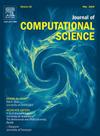Preconditioned CG and GMRES for interior point methods with applications in radiation therapy
IF 3.7
3区 计算机科学
Q2 COMPUTER SCIENCE, INTERDISCIPLINARY APPLICATIONS
引用次数: 0
Abstract
Interior point methods (IPMs) are widely used for different types of mathematical optimization problems. Many implementations of IPMs in use today rely on direct linear solvers to solve systems of equations in each iteration. The need to solve ever larger optimization problems more efficiently and the rise of hardware accelerators for general-purpose computing has led to much interest in using iterative linear solvers instead, though inevitable ill-conditioning of the linear systems remains a challenge. We investigate the use of the Krylov solvers CG, MINRES and GMRES for IPMs applied to optimization problems from radiation therapy. We implement a prototype IPM for convex quadratic programs and consider two different preconditioning strategies depending on the characteristics of the problem. One where a doubly augmented re-formulation of the Karush–Kuhn–Tucker linear system, originally proposed by Forsgren and Gill, is used together with a Jacobi-preconditioned conjugate gradient solver, and another with constraint preconditioning applied to a symmetric indefinite formulation of the linear system. Our results indicate that the proposed formulation provides sufficient accuracy. Furthermore, profiling of our prototype code shows that it is suitable for GPU acceleration, which may further improve its performance. The constraint preconditioner is shown to work well for cases with few, dense linear constraints, with a substantial improvement in linear solver convergence compared to the doubly augmented version. Our results indicate that our method can find solutions of acceptable accuracy in reasonable time for realistic problems from radiation therapy, as well as a simple test problem from support vector machine training. This is an extended version of a conference paper presented at the International Conference for Computational Science 2024 (Málaga, Spain) (Liu et al. 2024).
预置CG和GMRES内点法在放射治疗中的应用
内点法(IPMs)广泛应用于各种类型的数学优化问题。目前使用的许多ipm实现依赖于每次迭代中的直接线性求解器来求解方程组。更有效地解决更大的优化问题的需要和用于通用计算的硬件加速器的兴起,导致人们对使用迭代线性求解器产生了很大的兴趣,尽管线性系统不可避免的不良条件仍然是一个挑战。我们研究了Krylov解算器CG, MINRES和GMRES对ipm应用于放射治疗优化问题的使用。我们实现了凸二次规划的原型IPM,并根据问题的特点考虑了两种不同的预处理策略。其中一种是由Forsgren和Gill最初提出的Karush-Kuhn-Tucker线性系统的双增广重新表述,与jacobi预条件共轭梯度求解器一起使用,另一种是将约束预条件应用于线性系统的对称不定表述。结果表明,该公式具有足够的精度。此外,我们的原型代码的分析表明,它适合GPU加速,这可能会进一步提高其性能。约束预条件被证明可以很好地用于具有少量、密集线性约束的情况,与双增广版本相比,在线性解算器收敛方面有了实质性的改进。我们的结果表明,我们的方法可以在合理的时间内为放射治疗的实际问题以及支持向量机训练的简单测试问题找到可接受精度的解决方案。这是在2024年国际计算科学会议(Málaga,西班牙)上发表的一篇会议论文的扩展版本(Liu et al. 2024)。
本文章由计算机程序翻译,如有差异,请以英文原文为准。
求助全文
约1分钟内获得全文
求助全文
来源期刊

Journal of Computational Science
COMPUTER SCIENCE, INTERDISCIPLINARY APPLICATIONS-COMPUTER SCIENCE, THEORY & METHODS
CiteScore
5.50
自引率
3.00%
发文量
227
审稿时长
41 days
期刊介绍:
Computational Science is a rapidly growing multi- and interdisciplinary field that uses advanced computing and data analysis to understand and solve complex problems. It has reached a level of predictive capability that now firmly complements the traditional pillars of experimentation and theory.
The recent advances in experimental techniques such as detectors, on-line sensor networks and high-resolution imaging techniques, have opened up new windows into physical and biological processes at many levels of detail. The resulting data explosion allows for detailed data driven modeling and simulation.
This new discipline in science combines computational thinking, modern computational methods, devices and collateral technologies to address problems far beyond the scope of traditional numerical methods.
Computational science typically unifies three distinct elements:
• Modeling, Algorithms and Simulations (e.g. numerical and non-numerical, discrete and continuous);
• Software developed to solve science (e.g., biological, physical, and social), engineering, medicine, and humanities problems;
• Computer and information science that develops and optimizes the advanced system hardware, software, networking, and data management components (e.g. problem solving environments).
 求助内容:
求助内容: 应助结果提醒方式:
应助结果提醒方式:


